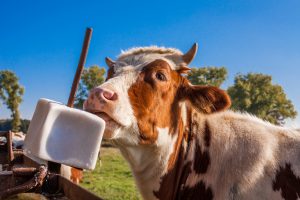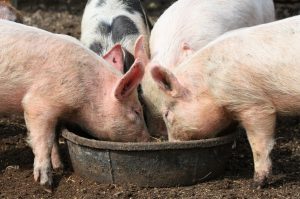Salt Toxicity in Livestock – What To Look For
Salt, while a necessary and crucial nutrient for any living thing, can be a double edged sword. Too much salt in your livestock’s diet can range from unhealthy to deadly. Couple that with too little water and it leads to high mortality rates. What can you do to make sure that your animals are happy and healthy? Start with complete access to free flowing, fresh and clean water.

First off, what is Salt Toxicity?
Salt Toxicity is an ailment caused by excessive salt intake. This is also known as Salt Poisoning or hypernatremia. Salt Toxicity, ST for short, affects all livestock although some species are more salt tolerant. Pigs are affected most by ST and sheep seem to be the most salt tolerant with horses and cattle falling in between, but it is worth monitoring for all species. Lethal doses are seen at 2.2g/kg in pigs, cattle and horses, while sheep can tolerate up to 6 g/kg.
Symptoms of Salt Toxicity
While symptoms of ST can vary in different species, there are a few overlapping symptoms such as brain lesions and gastric irritation in severe cases. Catching signs of acute toxicity is crucial. The first sign will be extreme thirst. As in any situation, monitoring your animals’ water supply is absolutely necessary. Free access to clean and fresh water is the easiest way to ensure salt levels remain at a normal level. Even recommended salt intake in everyday feed can lead to ST without access to water.
There are different symptoms for different animals though. For example pigs can become unresponsive to their environment, appearing deaf and blind. It has been reported that they will wonder aimlessly bumping into walls and other animals. In severe cases pigs will seize and lie on their sides paddling. Cattle will salivate, vomit and can have partial paralysis. You can also watch for cattle dragging hind feet or knuckling at the fetlock joint. Cattle have also shown signs of violent behavior when affected by ST. Poultry signs will range from beak discharge to weakness to partial paralysis.
Treatment
With signs of ST, the severity of the illness will deterine the treatent plan. If ST is in final stages, allowing the animal to drink freely will can cause lethal results. Water needs rationing to limit GI tract issues and lesions of the brain. Contact veterinary assistance when mitigating any signs of ST. Water limits require volumes equal to .5% of the animal’s body weight until symptoms recede, often over a period of several days. In severe cases, the best course of action may be to administer water by through a stomach tube. It is worth noting that in severe cases, the recovery rate is low.
How to avoid Salt Toxicity
 As previously mentioned, the best practice for avoid instances of salt toxicity is to have fresh and clean water readily available for your animals at all times. Access to a clean horse trough, filled stock tank or an automatic waterer are great options for this, but water management is an absolute necessity for overall animal health. Overcrowding and placement of the water source is can be an overlooked and easily fixed aspect when addressing water options.
As previously mentioned, the best practice for avoid instances of salt toxicity is to have fresh and clean water readily available for your animals at all times. Access to a clean horse trough, filled stock tank or an automatic waterer are great options for this, but water management is an absolute necessity for overall animal health. Overcrowding and placement of the water source is can be an overlooked and easily fixed aspect when addressing water options.
Keep the water as fresh and clean as possible and limit any stagnant dirty water sources that your animals may drink from. And, of course, in the winter, keeping any water sources thawed and a palatable temperature will go a long way for upping your livestock’s water intake. Feed can play a factor in this as well. Providing the correct feed for your animal is step one. In conjunction with this we must mention that cat and dog food contains high salt content so livestock should avoid it

